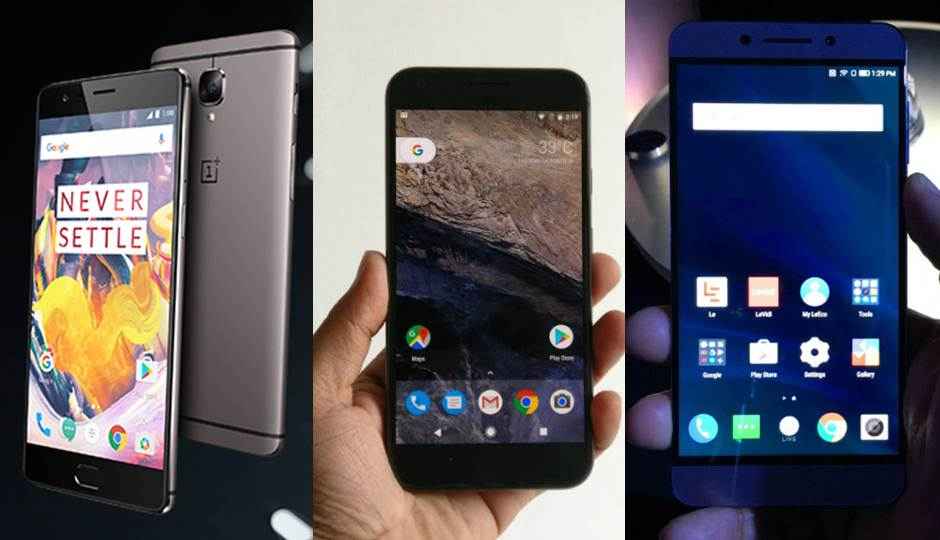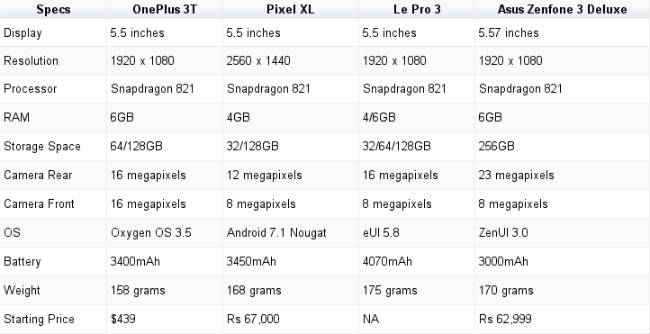OnePlus 3T v. Google Pixel XL v. LeEco Le Pro 3 v. ASUS ZenFone 3 Deluxe: Snapdragon 821 phones compared
Here's how the latest crop of Snapdragon 821-powered smartphones compare in terms of specifications.

The OnePlus 3T is now official, and with the arrival of the new flagship, OnePlus has done the most obvious thing – killed the previous flagship. In the case of OnePlus 3, it was not even six months old, but OnePlus has found enough reasons to go ahead with the decision. The OnePlus 3 is already officially dead in the US and Europe, and may soon be discontinued in India, too. The new OnePlus 3T improves on its predecessor in three key areas – speed, memory and battery life.
 Survey
SurveyThe switch from Qualcomm's Snapdragon 820 SoC to Snapdragon 821 may look modest on paper, but brings more efficiency to one of the best flagship Android phones. With this processor, OnePlus is also entering a territory that doesn't have much competition, but has Google's Android flagships, the Pixel and Pixel XL, as direct competitor. Other smartphones powered by Qualcomm's Snapdragon 821 SoC are the LeEco Le Pro 3 and Asus ZenFone 3 Deluxe. Both the devices are yet to launch in India, but their launch is imminent. Here, we see how the OnePlus 3T compares with Google's Pixel phones, LeEco Le Pro 3 and Asus ZenFone 3 Deluxe.
Design and Display
All the smartphones in this price range come with unibody metal design, which is a norm among flagship smartphones these days. The OnePlus 3T is crafted out of a single slab of "space-grade" aluminium alloy, like its sibling, OnePlus 3. At 7.3mm, the smartphone offers an elegant design and is comfortably thin with sharp lines and soft curves. The OnePlus 3T's biggest design differentiator is the use of an alert slider that offers complete control over notifications, somewhat in the nature of the iPhone.
If that design looks standard, then you should look at Google's less-than-standard design with Pixel. The Google Pixel features a dual-tone design of sorts, with metal and glass fused into a different look and feel. The smartphone is slim at the bottom, but takes a thicker curve at the top. Its a pretty unusual design among smartphones available in the market right now, although many have sworn semblance to Apple's flag-bearer. You may not like it, but it will never go unnoticed, especially the 'Very Blue' colour variant.
The LeEco Le Pro 3 and Asus Zenfone 3 Deluxe also offer unibody aluminium builds, but are similar to their predecessors in terms of design. The Zenfone 3 Deluxe is wider, but not that tall, considering its 5.7-inch display.
When it comes to displays, the LeEco Le Pro 3 is the only device to sport an IPS LCD panel. The OnePlus 3T uses the same 5.5-inch Full HD Optic AMOLED display, first seen on the OnePlus 3. It was arguably one of the best smartphone displays on budget flagships, and OnePlus seems to have reserved more enhancements for the OnePlus 4. The Asus Zenfone 3 Deluxe also offers a 5.7-inch Full HD Super AMOLED panel, but falls short in terms of pixel density.
While both the devices offer great displays, the Google Pixel XL offers an even crisper and brighter Quad HD AMOLED panel. While AMOLED panels are susceptible to oversaturation at times, it will come down to individual liking.
Performance and Battery Life
Google's Pixel and Google Pixel XL's highlight was the use of Snapdragon 821 with the latest Android 7.1 Nougat. The smartphones continue to dominate when it comes to integration of software and hardware. While OnePlus 3T, Zenfone 3 Deluxe and Le Pro 3 get the latest Snapdragon 821 under the hood, they are yet to receive the latest Android operating system update.
Google's Pixel XL here comes only with 4GB RAM, while the OnePlus 3T and Zenfone 3 Deluxe offer 6GB RAM out of the box. LeEco's Le Pro 3 comes in 4 and 6GB RAM variants, but we are yet to encounter an application that demands such resources. One thing is certain, it is always better to have maximum memory at disposal.
When it comes to battery life, however, the LeEco Le Pro 3 stands out from all the other devices. It houses a generous 4070mAh battery, and has modest specifications to drive it. Google's Pixel XL, on the other hand, packs a 3450mAh battery, which is decent enough to last one full day of heavy use.
The OnePlus 3T also jumps to a bigger 3400mAh battery, ensuring that it lasts one full day. OnePlus 3 already fared decently on battery tests, and a bigger battery should mean even longer endurance. Asus' Zenfone 3 Deluxe packs the smallest battery of the four phones here, but we observed that the standard Zenfone 3 lasted really well with a 3000mAh battery. It will be worth watching how the same fares with Snapdragon 821 SoC and 6GB RAM under the hood.
Camera
Google's Pixel and Pixel XL offer one of the best smartphone cameras in the market right now, and it truly shows its prowess. The Pixels use HDR+ mode by default, and is really fast in delivering the final result. The smartphone also launches the camera with one tap, which is a boon when you want to click on the move.
The OnePlus 3T should come close to it – and although it doesn't use a wide aperture lens and bigger pixels, the software is reliable and competent. The image sensor paired with OnePlus' Oxygen OS delivers great results on the OnePlus 3. The OnePlus 3T will also appeal to folks obsessed with selfies, and the newly improved 16MP front camera with PDAF should deliver better selfies in low light than competition.
Storage and Price
The LeEco Le Pro 3 and Google Pixel XL start with 32GB storage, while OnePlus starts from 64GB storage. Asus takes a significant storage leap by offering only one variant with 256GB onboard storage. OnePlus 3T, Pixel XL and LePro 3 can also be bought with 128GB storage – which is the new sweet spot among smartphones in terms of storage. The OnePlus 3T starts at $439 (approx. Rs. 30,000) for the 64GB variant, and while the 128GB variant is costlier by another $40 (Rs. 33,000), they both offer tremendous value for the money spent. Asus has announced a price of Rs 62,999 for its Zenfone 3 Deluxe, but the device is not yet available for purchase.
The LeEco Le Pro 3 is yet to launch in India, but it is expected to come with a disruptive pricing like all previous budget flagship smartphones from the company. Google's Pixel XL starts at Rs 67,000, which may sound huge, but Google is promising an experience that is only available on the Pixel phones, for now. If you want to stay ahead of the curve with stock Android experience and an assistant responding to 'Ok Google' all the time, the Pixel is practically the only device until further updates to the new Snapdragon 821 devices, soon.
Buy Oneplus 3t from Amazon at Rs.29998
Buy Oneplus 3 from Amazon at Rs.27999
